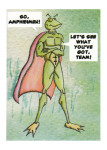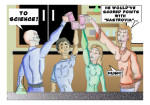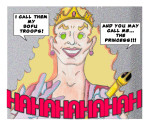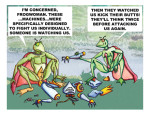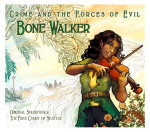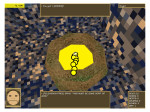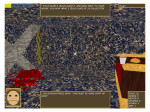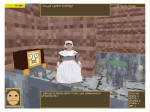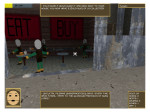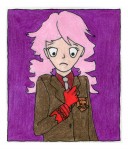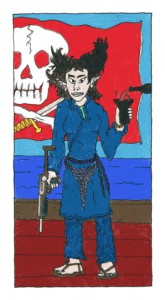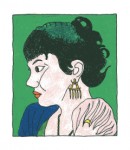A delightful, exhilarating fantasy adventure game of surpassing achievement. If you are unfamiliar with the yuri genre of culture then take a sensor reading!
I’m unsure how I happened upon this wonderful, multi-faceted gem of a game creation. It must have been one of those dreamlike internet sojourns, where you pass through an experience of mystery and find yourself exploring new possibilities of your own joy.
Luxaren Allure is a computer RPG done in the style of old school console games. If you’re familiar with Final Fantasy then the interface will be easy to absorb. Total game play is about 20 hours, though I spent more than that because I got sucked into every detail.
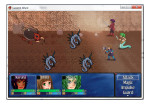 From what I can make out on the game’s website, it appears to be an indie collaborative project using RPG Maker VX Ace. This toolset and the style choice mean limitations on the graphics. You can’t expect wowsers stuff here visually. Fortunately, the imagination and intelligence of the gameplay transcend this condition to create genuine brain-expanding fun.
From what I can make out on the game’s website, it appears to be an indie collaborative project using RPG Maker VX Ace. This toolset and the style choice mean limitations on the graphics. You can’t expect wowsers stuff here visually. Fortunately, the imagination and intelligence of the gameplay transcend this condition to create genuine brain-expanding fun.
The story of the game takes place on the island of Luxaren. An ancient evil has returned to have another try at crushing the population and becoming ruler of the island.
Rising to the challenge of defeating this evil is an all female cast of adventurers, each with different abilities, dispositions, and goals. Can your gameplay guide them to victory?!
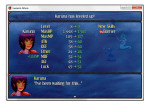 Your party starts with Karuna, a fighter selected by the local ruler to embody the hopes of her town that she is the heroine prophesized to save the island. She begins the core of protagonism that builds over time as others join the party and the story develops. Simple at first glance, but things soon become more complex!
Your party starts with Karuna, a fighter selected by the local ruler to embody the hopes of her town that she is the heroine prophesized to save the island. She begins the core of protagonism that builds over time as others join the party and the story develops. Simple at first glance, but things soon become more complex!
The wilderness and dungeon maps are varied and show cleverness. They’re hard enough to avoid being a breeze, but if you’re patient you can decipher the navigation. I appreciated this—I want a mild challenge without grinding through pathways.
If you forget what the most important current quest is while wandering about, the mission button in the party menu is available. This has the party members go over in a dialogue scene what they are currently trying to accomplish. This is a really nice touch.
 I mean, I can dig it; right? Group of people wandering around trying to do quest stuff. Wouldn’t they naturally take a break and talk about their goals? Especially after fighting tons of monsters and having only a vague idea of where they are right now? “Oh yeah, that’s right we were supposed to be looking for a town. Got it.”
I mean, I can dig it; right? Group of people wandering around trying to do quest stuff. Wouldn’t they naturally take a break and talk about their goals? Especially after fighting tons of monsters and having only a vague idea of where they are right now? “Oh yeah, that’s right we were supposed to be looking for a town. Got it.”
The NPCs are varied; they can be witty, ignorant, friendly, boring or insightful. Conversations get to the point while also showing a layer of depth. You can encounter them to get what you need, but you can also see that they make an internal sense. The first time around I only chatted with the people I came across, but later I searched everyone out just to see what they said. Their responses paint a diverse picture of people’s attitudes and priorities. You know, like real people do.
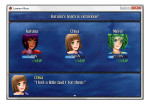 There are a number of puzzles and problems to overcome, all of which kept me guessing but not too much. You have to pay attention to what you’re doing, but you can eventually figure things out. This creates a smooth flow from one place to the next while also supporting that the party of adventurers are living an ideal. That’s romanticism that easily glides into your aesthetic sense.
There are a number of puzzles and problems to overcome, all of which kept me guessing but not too much. You have to pay attention to what you’re doing, but you can eventually figure things out. This creates a smooth flow from one place to the next while also supporting that the party of adventurers are living an ideal. That’s romanticism that easily glides into your aesthetic sense.
Monsters are often plain weird, disgusting or disturbing. People had a lot of fun putting these things together. There’s thought behind them though—they do require weakness analysis or you might find yourself getting worn down hard or surprised. The potion monster stands out as truly bizarre and puzzling.
Then there is the top notch music. A game like this soars or slogs through the selection of its soundtrack. Often the tracks are hypnotic, poignant, inspiring, or jarring. It opens up your heart to the thrill of what’s going on and the timing can create unexpected moments of elation.
I pulled out Audacity to convert these gems to mp3 so I could experience them outside the game arena. I could listen to this piece all day. That’s a sign that something is going on. The artists such as Monster Cyborg stand up to the best game music out there today.
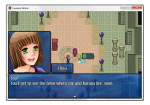 An interesting aspect to the strategy of the game is the Impulse characteristic. As characters take damage they gain Impulse, which can be used to fuel a whole subset of special abilities. Some of them are pretty amazing!
An interesting aspect to the strategy of the game is the Impulse characteristic. As characters take damage they gain Impulse, which can be used to fuel a whole subset of special abilities. Some of them are pretty amazing!
After a battle you lose 20% of your Impulse though, so you need to pay attention to the dynamics of a monster fight. This trait means your character does their normal routine, and then over time as the battle progresses, if they survive they start to become inspired and motivated by their ordeal to strike back and triumph. It’s a really nice way to game mechanic a struggle, overcoming adversity, and counterattacking.
So what makes this such an outstanding game? I think ultimately it’s the commitment to depth—the care in crafting a believable internal structure—with the stance of treating all the characters (not just the ones you guide) as fully realized people with agency. It’s that combined pair of ingredients that allows you to experience a fantasy adventure that is both a little bit of a struggle and a whole lot of exciting exhilaration.
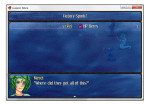 I had to play the game again two more times to get a better handle on this quality. Details emerge organically that are linked, many of which you miss as you try to solve the quest cornerstones. There are amazing big moments, but after a third playing I really started to enjoy how much thought went into making sure things hold together.
I had to play the game again two more times to get a better handle on this quality. Details emerge organically that are linked, many of which you miss as you try to solve the quest cornerstones. There are amazing big moments, but after a third playing I really started to enjoy how much thought went into making sure things hold together.
It’s amazing how different the terrain is with such limited elements. I never felt I was repeating myself even though there were times when I had to return to a similar tileset. It encourages familiarity over time with the useful repetition but keeps surprising you with new applications.
The party characters are really fantastic to play. Their romantic development is a delight to watch unfold; humanized conversancy, passion, and intimacy. They handle inner dilemmas and personal problems with an admirable dedication that hits home with relation to the big questions of life. Game designers should be taking notes here.
The struggle against the attempt to destroy the party by digging into their childhoods and finding their weaknesses is a highpoint with this technique. You get a clever exposition that deepens your appreciation for the characters while having to guide them through their fears.
The part with Chisa actually using this shadow-challenge as a catalyst to master her true strength after hiding herself in fear for half the game—pure storytelling mastery and a thrill. This is how you do it, folks.
The villains are well-developed too. There is complexity and nuance in how they express themselves, with more than a few surprises. A large part of conquering evil in this game is about conquering it in ourselves and having the courage to continue on, while also dispelling outmoded models of the past that are lingering way past their time. Now there’s a romantic message on many levels if I ever saw one!
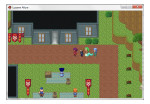 When I contemplate a party made up of queer women who all share a certain outsider status (with different backgrounds on that aspect) and take it into myself as an aspect of play, I find this game reveals a really extraordinary and inspiring journey of self discovery during a time of danger, romance, and testing. This is greatness in art and in culture.
When I contemplate a party made up of queer women who all share a certain outsider status (with different backgrounds on that aspect) and take it into myself as an aspect of play, I find this game reveals a really extraordinary and inspiring journey of self discovery during a time of danger, romance, and testing. This is greatness in art and in culture.
It isn’t utterly perfect. Not all the music fits, but I have to admit this is personal preference talking now and may not be a flaw since the game embodies such a large diorama of places and people here. Other than Karuna I didn’t see very many people of color, but they are there if you look (I checked). Hyperawareness of tropes and the use of ironic humor in some of the NPCs and characters might strike some people as off; I found it suits the character of the game marvelously.
However, these are weaksauce criticisms. The overall effect is beautiful. Believe in love, believe in friendship, and believe in yourself. These things are real and they can happen. This is what the highest forms of expression return us to when they are fresh, vital, and true to the open panorama of life. Cake and prizes are there and they can be had with a wholesome approach and a bit of light ordeal.
Cannot recommend this enough. This is a master crafted experience of human discovery.
5 out of 5 Stars of the Magi
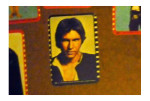 When I was a kid and deep into my new love of Star Wars, I drew people with tee shirts that said “star bores” on them. It was a mock from someone who relived the scenes from the movie every day for months.
When I was a kid and deep into my new love of Star Wars, I drew people with tee shirts that said “star bores” on them. It was a mock from someone who relived the scenes from the movie every day for months.






